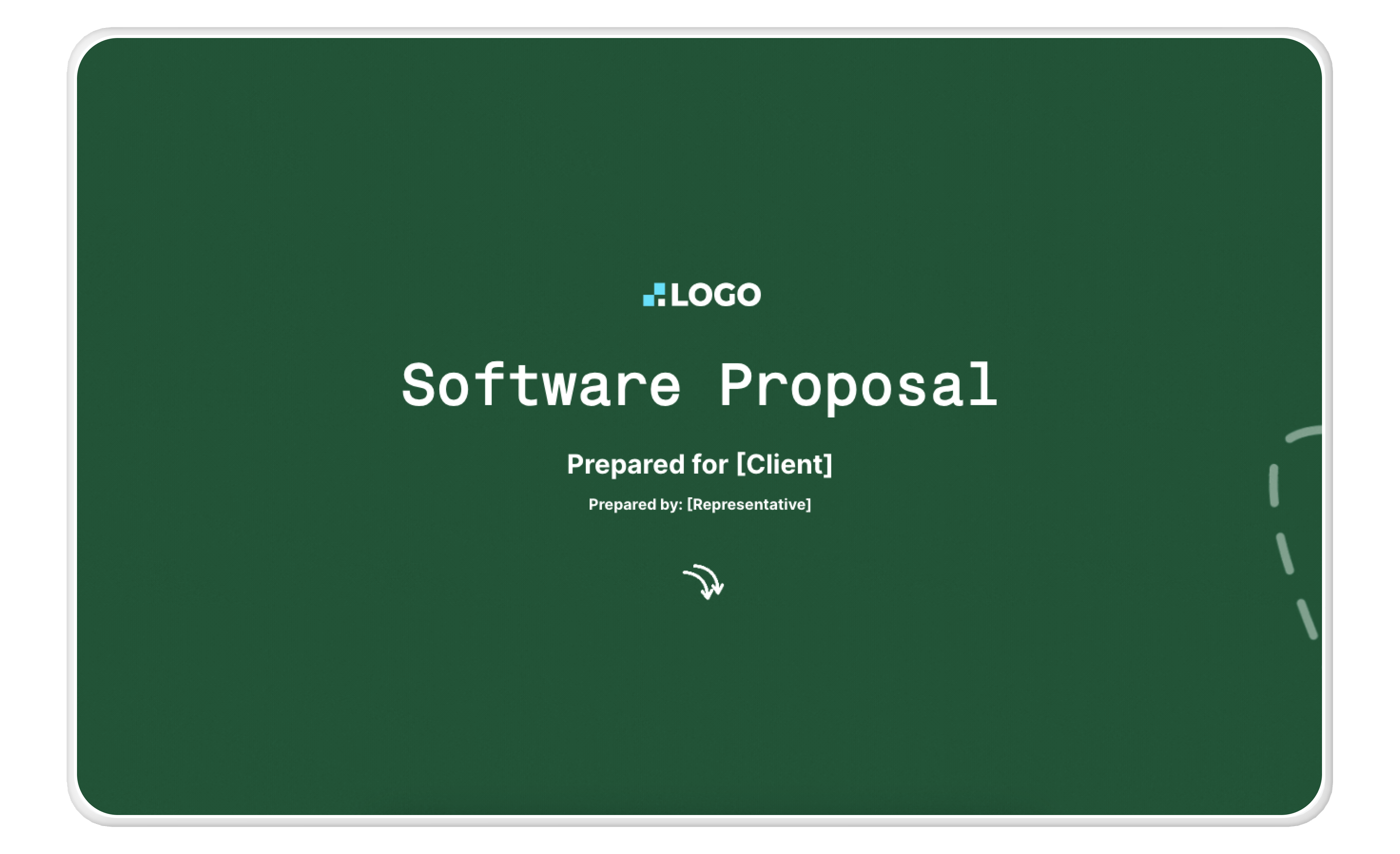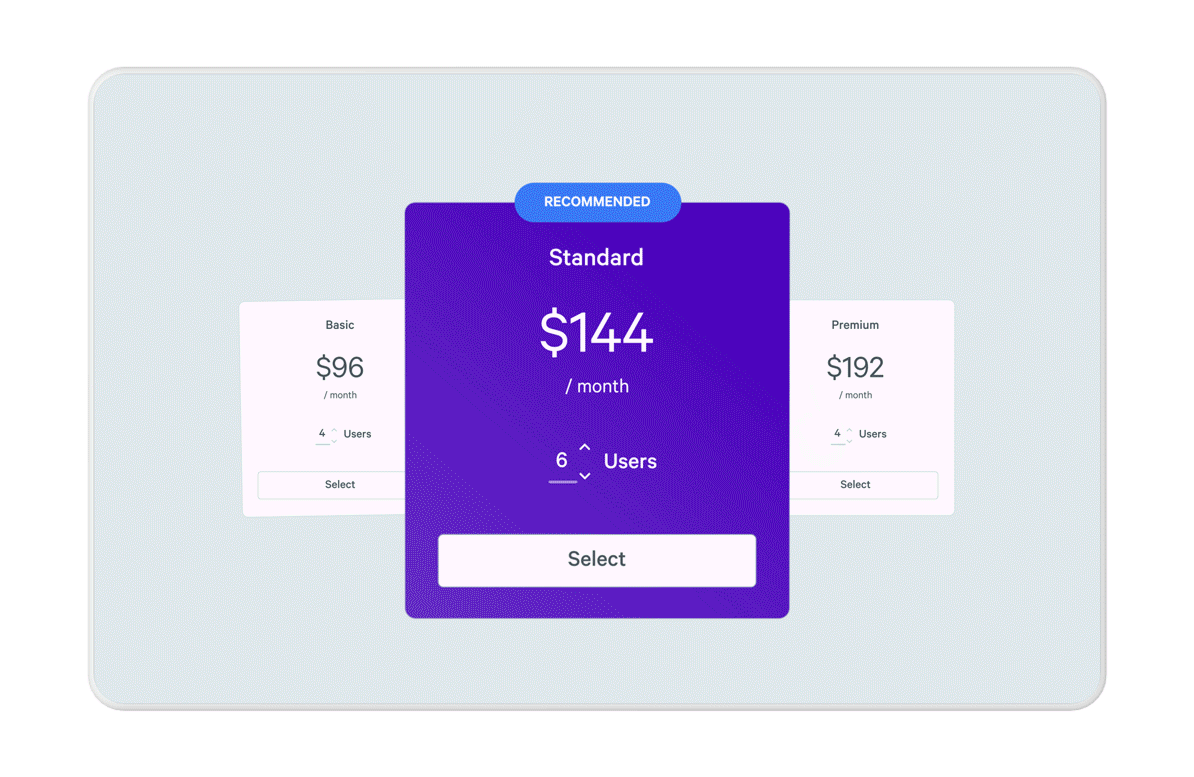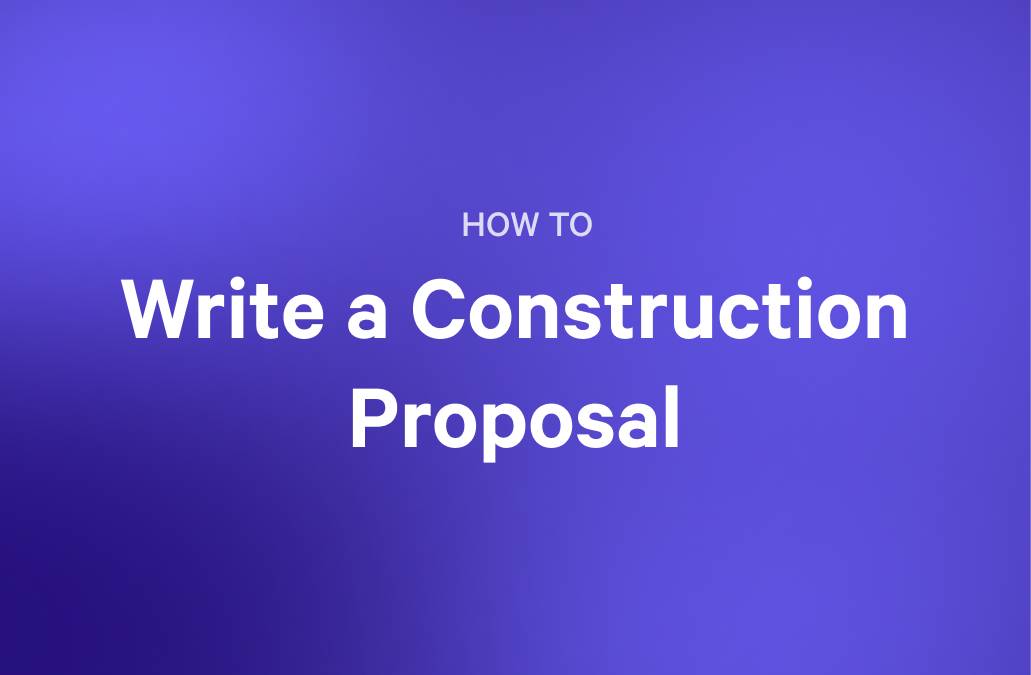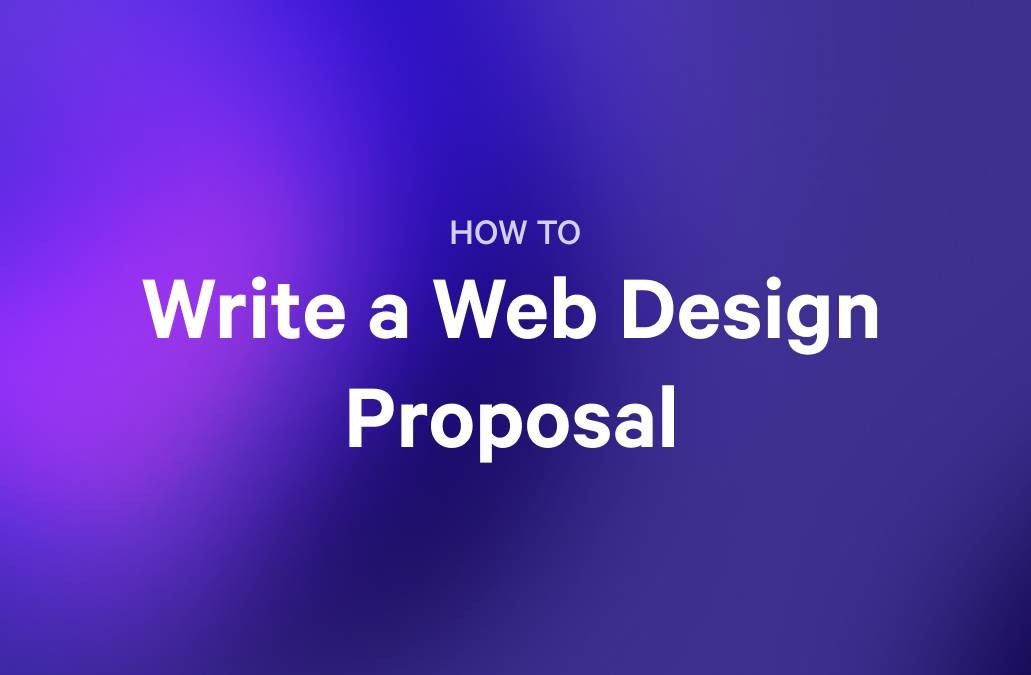In 2023, worldwide revenue in the software industry is expected to reach $658 billion. By 2028, it is expected to reach $858.10 billion in revenue.
That's a big market — and a big opportunity for pretty much any software developer. So, if you're in the market for new software development clients, now's the time to strike the iron while it's hot!
And if you want to do that, it’s important to take the time to get your sales processes in order so you can compete effectively, win more clients, and deliver more value.
How do you write a software proposal that's just as good as your software?
What is a software proposal?
A software development proposal is a written document that outlines how the work will be completed for a specific software development project including pricing information. Software development companies typically use it in their sales processes after one or more discovery sessions to pitch their services to potential clients, and it includes details such as the project objectives, scope of work, timeline, budget, and expected outcomes.
The main goal of a software proposal is to convince the client that your company is the best fit for their project and that your proposed solution will meet their specific needs. It serves as a roadmap for the development process and a starting point for sales negotiations between your software company and the client.
How to structure a compelling software proposal
To master the art of writing compelling software proposals, you must first understand how to write sales proposals in general. You can then apply the specific best practices and tailor the proposal to the software industry. In a nutshell, however, it all comes down to a few steps you need to take:
Identify your ideal customer's needs
This tends to be true for every type of B2B sales collateral, but it's essential when writing your sales proposal. You need to understand who your ideal customer is and what their biggest pain points are that you can solve. Only then can you craft a detailed proposal that speaks directly to those needs.
Don't deal in vague, general terms – take the time to understand who your existing customers are, who your future customers should be, what they do, what their pain points are, how they buy services like yours, and what motivates them.
Before you even start writing a proposal, it helps to map out and find the decision-makers and their needs and goals.
Get a software proposal template
If you want to save time, look professional, and create high-open-rate, high converting proposals, you must use a software proposal template. A well-designed template will help you organize your information in a logical manner and make it easier for the client to understand your proposed solution.
It also allows you to customize the design of your proposal, adding branding elements or images that align with your company's image. Using a template, you can save resources and focus on crafting a compelling message that resonates with your potential client. Qwilr's proposal software comes with many beautifully designed templates.
You can find Qwilr's Software Development Proposal Template below to get you started.

Personalize your proposal for every client
Getting a template and personalizing it is perfectly fine (and even recommended.)
Getting a template and changing a word here or there — well, it's not recommended. You want your customer to feel like you've taken the time to understand their needs and create a proposal tailored specifically to them.
That means taking the time to research new clients and their companies and understand their industry. You can take what you learned and incorporate those details into your proposal. Personalizing your proposal can make all the difference in winning over a potential client.
Highlight your unique selling proposition (USP)
What sets you apart from other software development teams?
It could be your track record of success, commitment to quality, top talent from around the world, or the best price-to-quality ratio. Whatever it is, highlight your USP in your software proposal.
This will help differentiate your company from competitors and give potential clients a clear reason for choosing you for their project.
Outline the project scope and deliverables
Your sales proposal is part pitch, part project management plan -- so while you may not go into the nitty-gritty of each feature of the software product and each iteration it will go through, you need to outline the scope of work and expected deliverables.
Include a high-level overview of the project timeline, phases, milestones, and key deliverables. This will give your potential clients an idea of what to expect from working with you and help manage their expectations throughout the project.
Provide a detailed budget
The budget is likely one of your potential clients' most significant decision-making factors. Be transparent and provide a detailed breakdown of the costs associated with the project, including any additional fees or expenses.
This will show that you have carefully considered their budget constraints and are offering a fair price for your services. It also demonstrates your professionalism and ability to manage finances effectively.

Provide a detailed timeline
Unless it's a tiny project, your customer shouldn’t expect you to get this done in a week. However, they do expect you to provide them with a timeline that is as accurate as possible. A lot of things may change down the way, including the features that are the highest priority, the team you have to work on the project, and any unknowns that are still lingering-- that's all fine, and you can more or less estimate them with a bit of insight from your own experience of working in the industry. You may also want to pad your estimate to give you some flexibility in case of unforeseen issues — this way, you don’t have to go back to your client and ask for more time later.
Include case studies or testimonials
Including success stories from previous projects and testimonials from satisfied clients can help boost your credibility and show the potential client that you have a track record of delivering successful software development projects.
This gives them confidence in your ability to deliver results and can help sway their decision in choosing your company for their project. Statistics don't lie here: 92% of B2B buyers are more likely to seal the deal after reading good reviews.
Why most software proposals miss the mark
Even the most skilled development teams can lose out if their proposals don’t match the quality of their code. Here's why many proposals fail—and how you can avoid the same fate:
- Lack of alignment before the proposal is sent. Deals get derailed when key terms, pricing, and timelines haven’t been mutually agreed on ahead of time. Your proposal should confirm, not introduce, these decisions.
- Too much “about us,” not enough “about you.” Buyers don’t want a wall of credentials. They want a clear path to ROI, framed in the context of their specific pain points and business goals.
- Unclear buying path. Particularly in enterprise or global businesses, failure to identify all key decision-makers and their internal processes leads to friction later.
To increase your win rate, treat the proposal as the culmination of a well-executed discovery process, not the start of it. Check out our data-backed video for more info:
Four ways to cut through the noise with your software proposals
You're likely not the only software house pitching your services to your client. This means you have to work extra hard to cut through the noise and deliver a proposal that speaks to your customer's pain points and unique needs. Here are four ways to do just that:

1. Use a quote from someone on their buying committee
Including a quote from your "champion" (the person you've been in touch with throughout the buying process) or another decision-maker can give your proposal a personal touch and make it stand out. It also shows that you have built a rapport with their team members, making them feel more comfortable and familiar with you.
People are always more willing to listen when you hook them with something familiar — and a quote from someone on your prospect's team is likely to do just that.
2. Tailor your proposal to address the smallest details
Every element of your proposal needs to be perfectly aligned with your potential customer, not just who you are. That includes the design, tone, language, and overall structure. Pay attention to every detail to ensure it resonates with your target audience.
For example, if your customer is an eCommerce company looking for agile development services for a mobile app, use industry-specific vocabulary and highlight how your approach aligns with their needs. You might mention your team’s training and certifications in the agile methodology and highlight how your agile workflows happen over the project lifecycle. This will help them see that you understand their world and are the right choice for their project.
Conversely, if your customer is a non-tech-savvy non-profit organization seeking custom software solutions, focus on showcasing how your services can help them achieve their mission and impact their community. Avoid using overly technical jargon, and write your proposal in easy-to-understand terms.
3. Include all your terms and conditions
It's important to be transparent and upfront about your terms and conditions for working with a potential client. This can include any fees, payment schedules, deliverables, functionality, or cancellation policies — any bit of info regarding your policy that might affect your customer. You might also spell out who on your team (or any contractors) might be working on the project so your prospective client can understand their experience.
Including these details in your proposal will prevent misunderstandings and show that you value clear communication and honesty in your business dealings. Your customer will appreciate it, and you can save your entire sales team from endless discussions down the road should your customer decide to start their project with you.
4. Track your proposal in your customer's approval process
You want to make sure your proposal got into the right hands and hasn't been sitting in someone's inbox for weeks on end. With Qwilr, you can track your proposal and see when your customer has opened it or viewed a specific section.
This not only helps you follow up at the right time but also allows you to tailor future communications based on their engagement with your proposal.
Additionally, this data can give you insights into which sections might need improvement and which ones are grabbing your customer's attention. This will help you continuously improve and refine your proposal for future pitches.
Data-driven proposal tactics that boost conversions
We studied over one million proposals to find out what works, and what you can leave behind along with your PDFs. These were our top findings:
Use fewer content blocks
Proposals with 6 or fewer content blocks sees a 66% higher average conversion rate compared to longer proposals. Simplicity sells.
Encourage team viewing
If multiple stakeholders view your proposal within 5 days, your acceptance rate nearly doubles. Want even better odds? Aim for 3+ viewers.
Add interactive elements
Interactive quote blocks and ROI calculators don’t just look slick—they increase acceptance rates by 1.7x. Empower buyers to play with numbers and see the value firsthand.
Aim for 4 minutes of engagement
If your buyer spends at least 4 minutes reviewing your proposal, their likelihood of accepting increases by over 1000%. That’s not a typo. Make it worth their time.
When and why proposals stall—and how to fix it
| Friction Point | Why It Happens | How to Overcome It |
|---|---|---|
Legal & procurement delays | Buyers bring in legal late, leading to redlines and revisions | Align with legal early; include transparent terms in your proposal |
Pricing hesitation in cost-sensitive orgs | High upfront cost without clear ROI | Lead with outcomes, not features; use interactive ROI calculators |
Lack of multi-threading | Proposal sent to one person who lacks full decision power | Engage additional stakeholders early; send follow-ups with analytics |
Internal stakeholder churn | Priorities shift or champions leave | Maintain regular touchpoints and visibility across the org |
With Qwilr analytics you can easily track buyer engagement across all of your proposals with deep page insights and real-time notifications. Find out when a prospect opens your proposal, which content they're engaging with, time spent on a page, and more.

Software proposal template example
If you’re new to writing software proposals or feel your proposals are getting stale or your win rate is going down, now might be a good time to look at some examples of successful software proposals to get inspired.
At Qwilr, we make it easy; we’ve developed a Software Development Proposal Template to get you started. This proposal includes everything you need to impress potential clients and win their business. It features:
- A smart, engaging design (you can simply change the colors and the logo, and you're ready to go)
- An executive summary section ( to bullet point the key themes and summarize your offering)
- A list of priorities you commit to
- A step-by-step 12-month project plan you can fill in with your outline (reduce this timeline for shorter projects)
- A situational assessment of your customer's current system (If you’re building something new, you can delete this section and keep it moving!)
- A development strategy (an overview of how you plan to develop the project)
- Success metrics and project goals you plan to implement
- A social proof section
- An overview of the next steps and another call to action (CTA - this could be to hit the accept button and sign the agreement)
- A legally binding eSignature and accept field (so you make your prospects’ life easier.)
- Your contact information and any additional relevant company details
Proposal success scorecard
Want a quick way to benchmark your proposal before hitting send? Use this 6-point scorecard to assess quality and impact:
| Element | Criteria Met? (✅/❌) |
|---|---|
Clear ROI and business impact | |
Personalized for this client | |
Interactive quote or pricing block | |
Multi-threaded recipient strategy | |
Concise, < 6 blocks | |
Pre-agreed commercial terms |
4+ ✅ = Strong likelihood of success
Less than 4? Revisit your approach before it stalls.
Get ready to start sending better software proposals today
Proposal writing does not have to feel as complex as coding in Pascal.
With the right tools and techniques, you can create a compelling proposal that captures your potential customer's attention and convinces them to choose your company for their software development needs.
Stay true to your company's mission, listen to your customer, and create proposals that address their concerns directly — instead of dancing around the vague features and benefits of your services.
About the author

Brendan Connaughton|Head of Growth Marketing
Brendan heads up growth marketing and demand generation at Qwilr, overseeing performance marketing, SEO, and lifecycle initiatives. Brendan has been instrumental in developing go-to-market functions for a number of high-growth startups and challenger brands.
FAQs
The contents of a software proposal depend on the specific project you're pitching for. However, usually, a software proposal should include information about your business, how it plans to solve a problem for your prospective client, what the timeline and budget are for this proposal, a section with the project payment schedule, as well as any terms and conditions you might want to include.
Writing a programming proposal doesn’t have to be overly complicated. The fastest way to write a programming proposal is by finding or creating a software or programming proposal template and adjusting it to your needs.
Many good proposal examples and business proposal templates are available, but be sure to download one that covers all the essentials, comes with great design "out of the box," is fully customizable, and gives your customer the option to accept the proposal right within the document.


